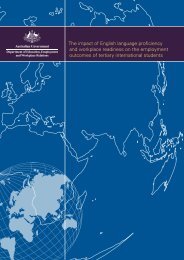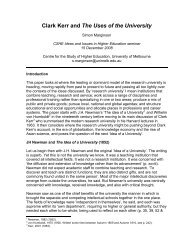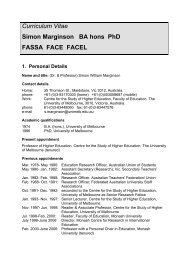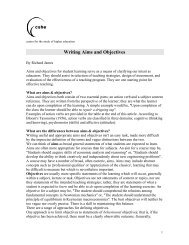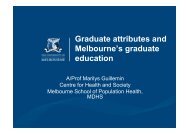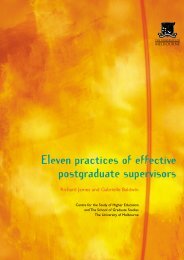The preparation of Mathematics Teachers in Australia - ACDS
The preparation of Mathematics Teachers in Australia - ACDS
The preparation of Mathematics Teachers in Australia - ACDS
You also want an ePaper? Increase the reach of your titles
YUMPU automatically turns print PDFs into web optimized ePapers that Google loves.
Chapter 3: <strong>The</strong> distribution <strong>of</strong> mathematics teach<strong>in</strong>g <strong>in</strong> schools<br />
This chapter describes the distribution <strong>of</strong> mathematics teach<strong>in</strong>g <strong>in</strong> schools, <strong>in</strong>clud<strong>in</strong>g the number <strong>of</strong><br />
mathematics teachers per school, their range <strong>of</strong> teach<strong>in</strong>g responsibilities, and differences <strong>in</strong> the<br />
pattern <strong>of</strong> staff<strong>in</strong>g between schools <strong>in</strong> different states. This data is essential for workforce plann<strong>in</strong>g,<br />
and yet is not readily available from exist<strong>in</strong>g data sources.<br />
Section 3.1 describes the numbers <strong>of</strong> mathematics teachers per school and the differences observed<br />
between different state/territory systems. This data was collected through the heads <strong>of</strong> mathematics<br />
survey, which asked heads to list the number <strong>of</strong> mathematics teachers at their school irrespective <strong>of</strong><br />
whether mathematics constituted all or only part <strong>of</strong> each person’s teach<strong>in</strong>g responsibility. As an<br />
<strong>in</strong>troduction to this section, the heads dataset is described <strong>in</strong> terms <strong>of</strong> state-based representation.<br />
Section 3.2 describes the pattern <strong>of</strong> teach<strong>in</strong>g responsibilities <strong>of</strong> mathematics teachers, <strong>in</strong>clud<strong>in</strong>g the<br />
range <strong>of</strong> mathematics and other subject teach<strong>in</strong>g. This data was collected from teachers directly. As<br />
an <strong>in</strong>troduction to this section, the pattern <strong>of</strong> mathematics subject <strong>of</strong>fer<strong>in</strong>gs by schools is presented.<br />
This <strong>in</strong>formation was collected from heads <strong>of</strong> mathematics.<br />
While some demographic <strong>in</strong>formation is <strong>in</strong>cluded, the demographics <strong>of</strong> mathematics teachers is<br />
covered more extensively <strong>in</strong> Chapter 6.<br />
In summary:<br />
• Schools had, on average, eleven people <strong>in</strong>volved <strong>in</strong> mathematics teach<strong>in</strong>g per school.<br />
• Most schools <strong>of</strong>fered elementary and <strong>in</strong>termediate senior school mathematics, while less than<br />
two-thirds <strong>of</strong>fered advanced senior mathematics.<br />
• <strong>Mathematics</strong> teachers taught a broad range <strong>of</strong> year levels.<br />
• Fifty per cent <strong>of</strong> mathematics teachers also taught other subjects.<br />
• Most teachers <strong>of</strong> senior school mathematics taught only mathematics.<br />
• New South Wales schools had fewer mathematics teachers per school, and these teachers<br />
taught a broader range <strong>of</strong> mathematics subjects. <strong>The</strong>y were also less likely to teach nonmathematics<br />
subjects.<br />
• <strong>The</strong> state-based differences <strong>in</strong> the size <strong>of</strong> mathematics departments were <strong>in</strong>dependent <strong>of</strong><br />
school size and geographic location.<br />
3.1 <strong>The</strong> number <strong>of</strong> mathematics teachers <strong>in</strong> schools<br />
3.1.1 Schools represented <strong>in</strong> the heads dataset<br />
Responses to the survey <strong>of</strong> heads <strong>of</strong> mathematics departments were received from 621 schools,<br />
represent<strong>in</strong>g all states and sectors (Table 3.1). <strong>The</strong> number <strong>of</strong> responses received from each<br />
state/territory reflected the size <strong>of</strong> the school system <strong>in</strong> that state/territory, with the possible<br />
exceptions <strong>of</strong> the Northern Territory and South <strong>Australia</strong>. <strong>The</strong> response rate for all other states and<br />
territories was between 19 and 26 per cent. <strong>The</strong> Northern Territory was under represented at 16 per<br />
cent and South <strong>Australia</strong> over represented at nearly 30 per cent.<br />
7



